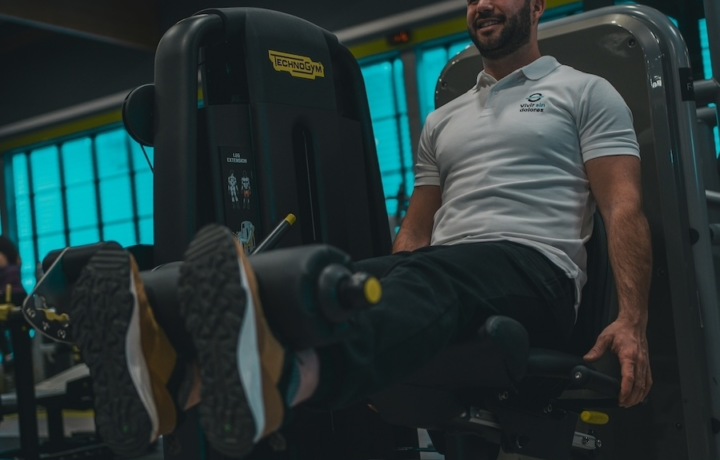Exercise
Barbell Step Up

Barbell Step Up
How to Perform
- Position a sturdy bench or platform in front of you and place a barbell across your upper back, resting on your trapezius muscles with your hands gripping the bar slightly wider than shoulder-width.
- Stand tall with feet hip-width apart, engage your core, and look straight ahead while maintaining a neutral spine position.
- Lift your right foot and place it completely flat on the bench, ensuring your knee is directly above your ankle and your weight is distributed evenly through your whole foot.
- Inhale deeply and brace your core as you prepare to drive upward, keeping your chest up and shoulders pulled back.
- Push through the heel of your right foot while maintaining a strong, stable torso to lift your entire body onto the platform, exhaling as you exert force.
- Bring your left foot up to meet your right foot on the platform, reaching a fully standing position with both feet on the bench and your hips fully extended.
- Step back down with the left foot first, controlling the descent by bending at the hip and knee while maintaining an upright torso position.
- Return your right foot to the starting position, completing one repetition, then repeat the movement leading with the opposite leg to ensure balanced development.
Important information
- Choose a bench height that allows your knee to form a 90-degree angle when your foot is placed on it—too high increases injury risk, too low reduces effectiveness.
- Keep your chest up and back straight throughout the entire movement to prevent excessive forward lean that could strain your lower back.
- Start with lighter weight or just body weight to master proper form before progressing to heavier loads.
- Drive through your heel rather than your toes to maximize glute and hamstring engagement while reducing knee stress.

Barbell Step Up
Exercise Details
Primary Muscles
Muscle Groups
Mechanic
Risk Areas
Built for progress
Take the guesswork out of training
Create personalized AI-powered workout plans that evolve with you. Train smarter, track every rep and keep moving forward, one workout at a time.






The Barbell Step Up stands as a versatile compound movement that delivers exceptional lower body development while challenging your balance and coordination. This intermediate-level exercise primarily targets the glutes, quads, and hamstrings, creating a comprehensive stimulus for lower body growth and functional strength.
When incorporated into bodybuilding routines, the Barbell Step Up excels at sculpting defined quadriceps, building rounder glutes, and developing hamstring definition with remarkable efficiency. The unilateral nature of this movement addresses muscular imbalances between your left and right sides, ensuring symmetrical development that both looks impressive and contributes to injury prevention.
For HIIT enthusiasts, this exercise serves as a powerful metabolic driver. The combination of weight-bearing resistance and the elevation change creates significant oxygen demand, elevating your heart rate and caloric expenditure. Many athletes report continued elevated metabolism for hours following Barbell Step Up sessions, making it valuable for body composition improvements.
From a strength perspective, the Barbell Step Up develops real-world power that translates directly to athletic performance. By training each leg independently while supporting additional load, you develop the kind of functional strength needed for jumping, climbing, and explosive sports movements. The stability requirements also engage your core and smaller stabilizing muscles that often get neglected in bilateral exercises.
What makes the Barbell Step Up particularly valuable is its scalability across fitness levels. While categorized as intermediate, the exercise can be adjusted through step height, barbell weight, and tempo to accommodate progression. Many strength coaches praise this movement for its joint-friendly nature compared to other loaded leg exercises, making it sustainable for long-term training programs.
For those seeking both aesthetic improvements and performance enhancements, few exercises deliver the comprehensive benefits of the properly executed Barbell Step Up in such an efficient package.
FAQ - Barbell Step Up
The barbell step up primarily targets your quadriceps, glutes, and hamstrings while also engaging your calves and core stabilizers. Your leading leg does most of the work, making this an excellent unilateral exercise for addressing muscle imbalances.
For optimal results, choose a platform height where your knee forms approximately a 90-degree angle when your foot is placed on top. Beginners should start with lower heights (12-15 inches) while advanced lifters can progress to higher platforms (18-24 inches) for increased range of motion.
To make the exercise easier, reduce the weight, lower the platform height, or hold the barbell in the front rack position. To increase difficulty, add more weight, use a higher platform, slow down the eccentric (lowering) phase, or add a pause at the top position.
Common mistakes include pushing off the floor with your back foot (instead of driving through the lead leg), leaning too far forward, rushing the movement, or using momentum. Focus on controlled movement, proper weight distribution, and maintaining an upright torso to maximize benefits and prevent injury.
Include barbell step ups 1-2 times per week as part of your lower body training, allowing at least 48 hours between sessions for recovery. They work well as a primary exercise on quad or glute-focused days or as an accessory movement after main lifts like squats or deadlifts.







